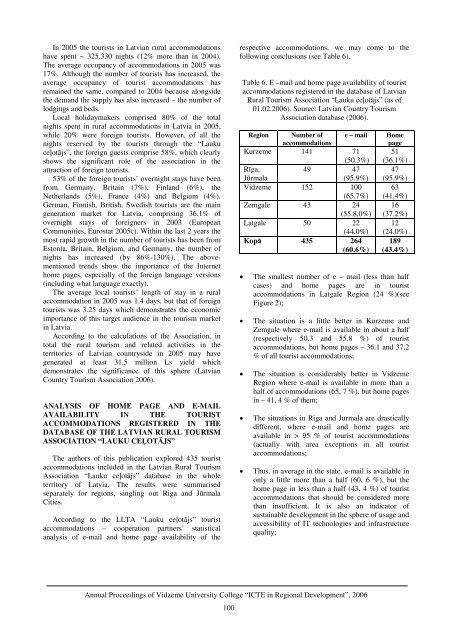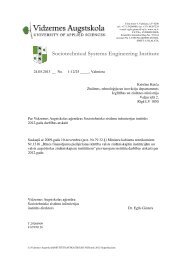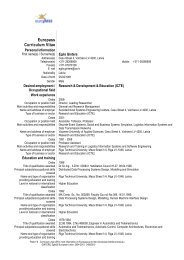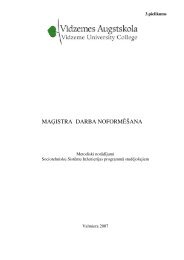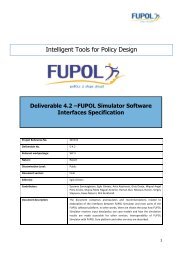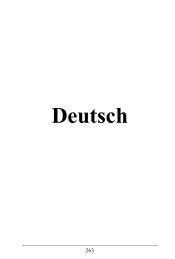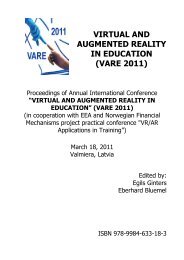Proceedings in pdf format. - Sociotechnical Systems Engineering ...
Proceedings in pdf format. - Sociotechnical Systems Engineering ...
Proceedings in pdf format. - Sociotechnical Systems Engineering ...
You also want an ePaper? Increase the reach of your titles
YUMPU automatically turns print PDFs into web optimized ePapers that Google loves.
In 2005 the tourists <strong>in</strong> Latvian rural accommodationshave spent ~ 325.330 nights (12% more than <strong>in</strong> 2004).The average occupancy of accommodations <strong>in</strong> 2005 was17%. Although the number of tourists has <strong>in</strong>creased, theaverage occupancy of tourist accommodations hasrema<strong>in</strong>ed the same, compared to 2004 because alongsidethe demand the supply has also <strong>in</strong>creased – the number oflodg<strong>in</strong>gs and beds.Local holidaymakers comprised 80% of the totalnights spent <strong>in</strong> rural accommodations <strong>in</strong> Latvia <strong>in</strong> 2005,while 20% were foreign tourists. However, of all thenights reserved by the tourists through the “Laukuceļotājs”, the foreign guests comprise 58%, which clearlyshows the significant role of the association <strong>in</strong> theattraction of foreign tourists.53% of the foreign tourists’ overnight stays have beenfrom Germany, Brita<strong>in</strong> (7%), F<strong>in</strong>land (6%), theNetherlands (5%), France (4%) and Belgium (4%).German, F<strong>in</strong>nish, British, Swedish tourists are the ma<strong>in</strong>generation market for Latvia, compris<strong>in</strong>g 36.1% ofovernight stays of foreigners <strong>in</strong> 2003 (EuropeanCommunities, Eurostat 2005c). With<strong>in</strong> the last 2 years themost rapid growth <strong>in</strong> the number of tourists has been fromEstonia, Brita<strong>in</strong>, Belgium, and Germany, the number ofnights has <strong>in</strong>creased (by 86%-130%). The abovementionedtrends show the importance of the Internethome pages, especially of the foreign language versions(<strong>in</strong>clud<strong>in</strong>g what language exactly).The average local tourists’ length of stay <strong>in</strong> a ruralaccommodation <strong>in</strong> 2005 was 1.4 days, but that of foreigntourists was 3.25 days which demonstrates the economicimportance of this target audience <strong>in</strong> the tourism market<strong>in</strong> Latvia.Accord<strong>in</strong>g to the calculations of the Association, <strong>in</strong>total the rural tourism and related activities <strong>in</strong> theterritories of Latvian countryside <strong>in</strong> 2005 may havegenerated at least 31.5 million Ls yield whichdemonstrates the significance of this sphere (LatvianCountry Tourism Association 2006).ANALYSIS OF HOME PAGE AND E-MAILAVAILABILITY IN THE TOURISTACCOMMODATIONS REGISTERED IN THEDATABASE OF THE LATVIAN RURAL TOURISMASSOCIATION “LAUKU CEĻOTĀJS”The authors of this publication explored 435 touristaccommodations <strong>in</strong>cluded <strong>in</strong> the Latvian Rural TourismAssociation “Lauku ceļotājs” database <strong>in</strong> the wholeterritory of Latvia. The results were summarisedseparately for regions, s<strong>in</strong>gl<strong>in</strong>g out Riga and JūrmalaCities.Accord<strong>in</strong>g to the LLTA “Lauku ceļotājs” touristaccommodations – cooperation partners’ statisticalanalysis of e-mail and home page availability of therespective accommodations, we may come to thefollow<strong>in</strong>g conclusions (see Table 6).Table 6. E –mail and home page availability of touristaccommodations registered <strong>in</strong> the database of LatvianRural Tourism Association “Lauku ceļotājs” (as of01.02.2006). Source: Latvian Country TourismAssociation database (2006).Region Number ofaccommodationse – mailKurzeme 141 71(50.3%)Rīga,49 47Jūrmala(95.9%)Vidzeme 152 100(65,7%)Zemgale 43 24(55.8,0%)Latgale 50 22(44.0%)Kopā 435 264(60.6%)Homepage51(36.1%)47(95.9%)63(41,4%)16(37.2%)12(24.0%)189(43.4%)• The smallest number of e – mail (less than halfcases) and home pages are <strong>in</strong> touristaccommodations <strong>in</strong> Latgale Region (24 %)(seeFigure 2);• The situation is a little better <strong>in</strong> Kurzeme andZemgale where e-mail is available <strong>in</strong> about a half(respectively 50.3 and 55.8 %) of touristaccommodations, but home pages – 36.1 and 37.2% of all tourist accommodations;• The situation is considerably better <strong>in</strong> VidzemeRegion where e-mail is available <strong>in</strong> more than ahalf of accommodations (65, 7 %), but home pages<strong>in</strong> – 41, 4 % of them;• The situations <strong>in</strong> Riga and Jurmala are drasticallydifferent, where e-mail and home pages areavailable <strong>in</strong> > 95 % of tourist accommodations(actually with area exceptions <strong>in</strong> all touristaccommodations;• Thus, <strong>in</strong> average <strong>in</strong> the state, e-mail is available <strong>in</strong>only a little more than a half (60, 6 %), but thehome page <strong>in</strong> less than a half (43, 4 %) of touristaccommodations that should be considered morethan <strong>in</strong>sufficient. It is also an <strong>in</strong>dicator ofsusta<strong>in</strong>able development <strong>in</strong> the sphere of usage andaccessibility of IT technologies and <strong>in</strong>frastructurequality;Annual <strong>Proceed<strong>in</strong>gs</strong> of Vidzeme University College “ICTE <strong>in</strong> Regional Development”, 2006100


